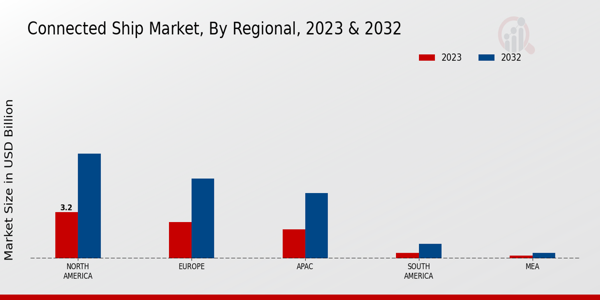Regulatory Compliance
The Global Connected Ship Market Industry is significantly influenced by stringent regulatory compliance requirements aimed at enhancing maritime safety and environmental protection. Governments worldwide are implementing regulations that mandate the adoption of connected technologies to monitor emissions, ensure vessel safety, and improve operational transparency. For example, the International Maritime Organization has established guidelines that encourage the use of digital technologies for better compliance with environmental standards. This regulatory push not only drives the adoption of connected ship technologies but also fosters innovation within the industry, as companies seek to develop solutions that meet these evolving standards.
Market Growth Projections
The Global Connected Ship Market Industry is projected to experience substantial growth over the coming years. With an estimated market value of 8.38 USD Billion in 2024, it is anticipated to reach 24.3 USD Billion by 2035. This growth trajectory indicates a compound annual growth rate of 10.18% from 2025 to 2035. Such projections reflect the increasing adoption of connected technologies across the maritime sector, driven by factors such as technological advancements, regulatory compliance, and a growing emphasis on sustainability. The market's expansion is indicative of the broader trends shaping the future of maritime operations.
Technological Advancements
The Global Connected Ship Market Industry is experiencing rapid technological advancements that enhance operational efficiency and safety. Innovations such as the Internet of Things (IoT), artificial intelligence, and big data analytics are being integrated into maritime operations. These technologies enable real-time monitoring of ship performance, predictive maintenance, and improved navigation systems. For instance, the implementation of IoT devices allows for seamless communication between vessels and shore-based operations, leading to optimized fuel consumption and reduced operational costs. As a result, the market is projected to grow from 8.38 USD Billion in 2024 to 24.3 USD Billion by 2035, reflecting a robust CAGR of 10.18% from 2025 to 2035.
Growing Focus on Sustainability
The Global Connected Ship Market Industry is increasingly aligning with global sustainability goals, driven by the need to reduce the environmental impact of maritime operations. Shipping companies are adopting connected technologies to monitor and manage emissions more effectively, thereby contributing to international efforts to combat climate change. For example, the integration of real-time data analytics enables vessels to optimize fuel usage, leading to lower greenhouse gas emissions. This shift towards sustainable practices not only meets regulatory requirements but also appeals to environmentally conscious consumers, further driving the adoption of connected ship technologies within the industry.
Market Expansion in Emerging Economies
The Global Connected Ship Market Industry is poised for expansion in emerging economies, where maritime trade is rapidly growing. Countries in Asia-Pacific and Africa are investing in port infrastructure and shipping capabilities, leading to increased demand for connected ship technologies. For instance, nations such as India and Nigeria are enhancing their maritime sectors to boost economic growth, creating opportunities for connected solutions that improve operational efficiency and safety. This trend is likely to contribute to the overall growth of the market, as these regions adopt advanced technologies to modernize their shipping industries.
Increased Demand for Operational Efficiency
The Global Connected Ship Market Industry is witnessing a growing demand for operational efficiency among shipping companies. As competition intensifies, operators are increasingly seeking ways to reduce costs and enhance productivity. Connected ship technologies facilitate this by providing insights into fuel consumption, maintenance needs, and route optimization. For instance, data analytics can identify inefficiencies in operations, allowing companies to make informed decisions that lead to cost savings. This focus on efficiency is expected to propel the market forward, as companies recognize the potential for connected technologies to streamline operations and improve overall profitability.























Leave a Comment